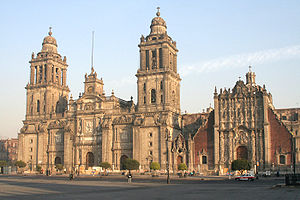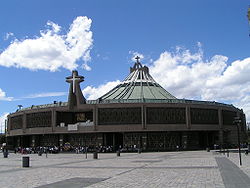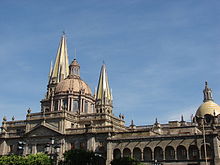- Roman Catholicism in Mexico
-
The Catholic Church in Mexico is part of the worldwide Roman Catholic Church, under the spiritual leadership of the Pope, Curia in Rome, and the Mexican Episcopal Conference. Being the dominant religion in the country for centuries, it has not been immune to criticism and sanctions from both citizens and the government.
Contents
History
Status of the Catholic Church in Mexico (1876-1911)
Exterior view of the modern Basilica of Our Lady of Guadalupe.
During the period of 1876 to 1911, relations between the Roman Catholic Church and the Mexican government were stable.
Porfirio Díaz, the President of Mexico during most of this period, was worried about the United States expansionist threat. Porfirio Díaz has been quoted as saying:
- “Persecution of the Church, whether or not the clergy enters into the matter, means war, and such a war, the Government can win it only against its own people through the humiliating, despotic, costly and dangerous support of the United States. Without its religion, Mexico is irretrievably lost.”
Diaz strengthened the Mexican government ties with the Catholic Church with an agreement formulated in 1905. The Church’s influence over Mexico transcended due to the amount of changes that occurred while Díaz was in power. These institutional reforms included: administrative reorganization, improved training of the laity, the expansion of the Catholic press, an expansion of Roman Catholic education, and the growth of Church’s influence in rural areas. The lack of enforcement of anti-clerical laws by Diaz can also be attributed to the profound influence of his wife who was a devout Catholic.
Mexican Revolution
Main article: Mexican RevolutionEarly Stages
After Francisco Madero’s victory over Porfirio Díaz, he continued to have close ties with the Catholic Church. As the Mexican Revolution progressed, the Constitutionalists of Venustiano Carranza denounced clerical involvement in Mexican governmental affairs. They protested that they were not persecuting the Catholic religion but wanted to reduce the Church’s political influence. The Constitutionalists did not at first take any formal action.
Constitutionalists take action (1914)
Álvaro Obregón and the Constitutionalists eventually took active measures to reduce the profound influence of the Catholic Church. On May 19, 1914, Obregón's forces sentenced Bishop Andres Segura and other clerical officials to jail for eight years because of their participation in a revolt. While Obregón was in control of Mexico City during February 1915, he ordered the Church to pay 500,000 pesos to alleviate the suffering of poor Mexicans.
Venustiano Carranza assumed the presidency on May 1, 1915. Carranza and his followers felt that the clergy was turning people against him by spreading propaganda. Soon after Carranaza took total control of Mexico and developed a new Constitution with the intention of diminishing the Church’s political sway and power within Mexico.
1917 Mexican Constitution
Anti-clerical elements were included in 1917 Mexican Constitution. Five elements in the Constitution were aimed at reducing the Catholic Church’s influence in Mexican domestic affairs. Article 3 enforced secular education in Mexican schools. Monastic vows and orders were outlawed in Article 5. Article 24 prevented public worship outside the confines of the Church buildings. According to article 27, religious institutions were denied the right to acquire, hold, or administer real property. Furthermore, all real estate held by religious institutions through third parties like hospitals, schools, was declared national property. Finally in article 130, it declared all basic civil responsibilities like voting or commenting on public affairs was taken away from Church officials. The Mexican government was extremely harsh in their attempt to eliminate the Catholic Church’s legal existence in Mexico. The stern premises of the 1917 Constitution contributed to the rise of resentment between the church and state.
Aftermath
For eight years after these provisions were instituted they were not rigorously enforced by the Mexican government. This changed in 1926 when Plutarco Elías Calles reinforced laws to decrease clerical power. In June 1926, Calles recognized a decree often referred to as “Calles Law.” Under this provision, Article 130 of the 1917 Mexican Constitution was re-established. Church officials were upset by the suddenness of Calles’ decision. The regulation which annoyed the Catholic Church was Article 19, which decreed the compulsory registration of the clergy, for it allowed the Government to hand over churches.”
The Catholic Church took a stand against the Mexican government. The internal political dissension became a concern for all Mexicans since the regulations imposed by Calles reduced the Catholic Church's influence. The disagreement turned violent when over five thousand Cristeros initiated an armed rebellion. The Mexican government and the Catholic Church engaged in bloody battle which lasted for a three-year period.
Organization
The Catholic Church is the world's largest Christian church, and its largest religious grouping. The 2000 census reported that Mexico had some 101,456,786 Catholics among the population aged five and above, which equates to around 91% of the total population, making it the second largest Roman Catholic country in the world after Brazil. The country is divided into 90 dioceses, and there are 15,700 priests and 46,000 men and women in religious orders. The Metropolitan provinces were rearranged on 25 November 2006:
 Cathedral of Our Lady of the Assumption in Oaxaca
Cathedral of Our Lady of the Assumption in Oaxaca
- Acapulco
- Antequera, Oaxaca
- Chihuahua
- Durango
- Gómez Palacio
- Mazatlán
- Torreón
- Prelature of El Salto
- Guadalajara
- Aguascalientes
- Autlán
- Ciudad Guzmán
- Colima
- San Juan de los Lagos
- Tepic
- Prelature of Jesús María
- Hermosillo
- Jalapa (Xalapa)
- León
- Mexico
- Atlacomulco
- Cuernavaca
- Tenancingo
- Toluca
- Monterrey
- Morelia
- Puebla de los Angeles, Puebla
- San Luis Potosí
- Tijuana
- Tlalnepantla
- Cuautitlán
- Ecatepec
- Netzahualcóyotl
- Teotihuacan
- Texcoco
- Valle de Chalco
- Tulancingo
- Tuxtla Gutiérrez
- Yucatán
Other Mexican Catholic Jurisdictions
There are also separate jurisdictions of the Catholic Church in Mexico, including the Maronite Catholic Eparchy of Nuestra Señora de los Mártires del Libano in Mexico, the Melkite Catholic Eparchy of Nuestra Señora del Paraíso in Mexico, the Armenian Catholic Apostolic Exarchate of Latin America and Mexico, and the The Missionary Sons of the Immaculate Heart of Mary in Rome, The Claretian Order.[1]
See also
References
External links
- Catholics in Mexico, by state (INEGI)
 "Mexico". Catholic Encyclopedia. New York: Robert Appleton Company. 1913.
"Mexico". Catholic Encyclopedia. New York: Robert Appleton Company. 1913.
Roman Catholicism in North America Sovereign states - Antigua and Barbuda
- Bahamas
- Barbados
- Belize
- Canada
- Costa Rica
- Cuba
- Dominica
- Dominican Republic
- El Salvador
- Grenada
- Guatemala
- Haiti
- Honduras
- Jamaica
- Mexico
- Nicaragua
- Panama
- Saint Kitts and Nevis
- Saint Lucia
- Saint Vincent and the Grenadines
- Trinidad and Tobago
- United States
Dependencies and
other territories- Anguilla
- Aruba
- Bermuda
- Bonaire
- British Virgin Islands
- Cayman Islands
- Curaçao
- Greenland
- Guadeloupe
- Martinique
- Montserrat
- Puerto Rico
- Saint Barthélemy
- Saint Martin
- Saint Pierre and Miquelon
- Saba
- Sint Eustatius
- Sint Maarten
- Turks and Caicos Islands
- United States Virgin Islands
Categories:- Roman Catholic Church in Mexico
- Roman Catholic Church by country
- Mexican Revolution
Wikimedia Foundation. 2010.




